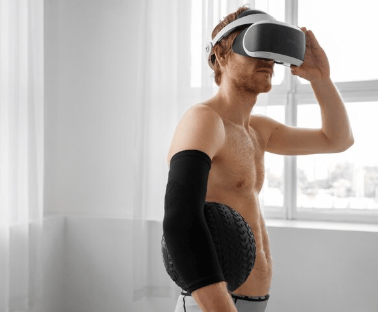In 2025, wellness is getting smarter—and biohacking is leading the charge. Once reserved for Silicon Valley insiders and elite athletes, biohacking for wellness is now more mainstream, more affordable, and more personalized than ever.
At its core, biohacking blends science, self-experimentation, and optimization. It’s about using technology, nutrition, data, and lifestyle tweaks to upgrade the body and mind. From tracking glucose in real time to using red light therapy for recovery, biohackers are reshaping what self-care looks like.
But this isn’t just for performance junkies anymore. Everyday people are using biohacking in 2025 to boost energy, improve sleep, sharpen focus, and support longevity. The tools? Smarter wearables, personalized supplements, brain training apps, and even DIY cold plunges.
This article dives into the latest innovations and practical methods shaping the biohacking movement right now. Whether you’re curious about where to start or looking to level up your routine, you’ll find the insights you need to make science-backed wellness work for you.
What Is Biohacking in the Wellness Context?
Biohacking is the art and science of self-optimization. In wellness, it means using data, habits, and tools to improve how your body and mind perform—often in measurable ways.
At its core, biohacking blends biology with technology and behavior change. The goal? To enhance energy, boost focus, sharpen recovery, support longevity, and feel better than “normal.”
Some wellness biohacks are simple and low-tech. Think intermittent fasting, cold exposure, or daily breathwork. Others use more advanced tools, like smart wearables, neurofeedback devices, or even genetic testing to fine-tune health on a personal level.
What sets biohacking apart from standard self-care is the mindset. It’s about experimenting, tracking results, and adjusting based on what works for your unique body. You’re not just guessing—you’re collecting data and using it to guide your decisions.
The beauty of biohacking in 2025 is its accessibility. You don’t need a lab or a six-figure income to get started. With the right information and intention, wellness biohacks can be a powerful way to take control of your health—one upgrade at a time.
Top Biohacking Trends in 2025
Biohacking has evolved from niche experimentation to a full-fledged wellness movement. In 2025, cutting-edge wellness tools are more precise, more affordable, and backed by growing research. Here are the top biohacking trends shaping the way we optimize our health.
A. Longevity-Focused Supplementation
One of the most explosive areas of biohacking right now? Longevity supplements. In 2025, we’re seeing a huge spike in interest around molecules that support cellular regeneration and age reversal.
Compounds like NMN (nicotinamide mononucleotide), spermidine, fisetin, and resveratrol are leading the pack. These supplements target key aging mechanisms—like mitochondrial decline, inflammation, and senescent cells. Researchers are particularly excited about spermidine’s role in autophagy (cellular cleanup) and fisetin’s senolytic properties.
Many biohackers now use stacked regimens combining multiple longevity compounds. These stacks are often paired with fasting, sleep optimization, and metabolic tracking for synergistic effects. While more human trials are underway, early data and user feedback suggest these protocols may support healthier aging—and possibly extend healthspan.
B. Red Light Therapy
Red light therapy has gone from niche recovery tool to household essential in 2025. With the rise of at-home red light panels and even full-body beds, more people are experiencing its benefits on demand.
How does it work? Red and near-infrared light penetrate the skin and stimulate mitochondrial energy production, specifically ATP synthesis. This boosts cellular repair, reduces inflammation, and enhances circulation.
People use red light therapy for:
- Skin rejuvenation and acne reduction
- Faster post-workout recovery
- Joint pain and stiffness
- Mood support, especially in darker months
Devices like Joovv, Mito Red, and Bon Charge are making this tech accessible, and ongoing studies continue to validate its broad spectrum of wellness benefits.
C. Wearable Technology for Optimization

Biohackers love data—and wearable tech biohacks are taking personal optimization to the next level in 2025. Today’s devices track everything from HRV (heart rate variability) to glucose levels, oxygen saturation, and sleep stages—all in real time.
Tools like the Oura Ring, WHOOP 4.0, Levels, and Ultrahuman allow users to see how every choice (meals, workouts, stress, sleep) impacts their body’s internal state. This feedback loop makes it easier to build smarter routines, avoid burnout, and fine-tune recovery.
Some platforms are now using AI coaching to make personalized recommendations based on daily metrics. It’s biohacking with brains—helping you shift from reactive health management to proactive performance.
>>Related: Top Wearables for Health Tracking in 2025
D. Cold Exposure + Breathwork
Cold therapy isn’t just a trend—it’s a proven protocol for building stress resilience and boosting metabolic flexibility. In 2025, more people are embracing ice baths, cryotherapy chambers, and Wim Hof–style breathwork for physical and mental gains.
Regular cold exposure has been shown to:
- Improve circulation
- Reduce inflammation
- Enhance dopamine and norepinephrine levels
- Activate brown fat for better metabolic function
Combined with breathwork, which balances the nervous system and increases oxygen efficiency, this practice helps regulate mood, sharpen focus, and calm anxiety. Plus, it’s one of the most accessible tools—just add ice and breathe.
E. Nootropics for Focus & Mood
As workplace burnout and attention fatigue grow, nootropics in 2025 are hotter than ever. These cognitive enhancers now blend adaptogens, racetams, and functional mushrooms like lion’s mane, cordyceps, and reishi to boost brain performance without the crash.
Biohackers use nootropics to:
- Improve memory and learning
- Increase focus and creativity
- Support emotional resilience
- Stabilize mood and reduce stress
Many formulas now come in stackable formats, allowing users to tailor blends for workdays, workouts, or downtime. With more research emerging on compounds like bacopa monnieri, L-theanine, and Alpha-GPC, nootropics are entering a golden age of functional brain support.
F. Personalized Data-Driven Protocols
Generic health advice is out. Personalized biohacking is in.
In 2025, it’s easier than ever to run your own lab. DNA analysis, gut microbiome testing, continuous glucose monitors, and blood biomarker tracking are all being used to craft hyper-personalized wellness routines. People are no longer guessing what works—they’re measuring it.
What’s more, AI-powered health apps are integrating these data streams to offer targeted protocols for diet, exercise, supplementation, and recovery. It’s the future of wellness—tailored down to your genes, cells, and microbes.
This shift toward data-driven customization is creating a new era in health optimization—one that’s efficient, empowering, and entirely unique to the individual.
Benefits & Risks of Biohacking
Biohacking offers exciting possibilities for enhancing health and wellness, but it’s essential to approach it with both enthusiasm and caution. Understanding the benefits and risks of biohacking can help you make informed decisions on your self-optimization journey.
Benefits
At its best, biohacking can improve physical performance, mental clarity, and longevity. By leveraging technology and personalized interventions, many users report sharper focus, better sleep, faster recovery, and increased energy. The ability to track and adjust lifestyle factors empowers individuals to take control of their health in ways that traditional medicine often cannot provide.
Biohacking also fosters a mindset of continuous learning and experimentation, encouraging people to tune into their bodies and identify what truly works for them. This self-awareness can lead to sustainable, long-term wellness improvements rather than quick fixes.
Risks
Despite its appeal, biohacking comes with potential downsides. Many supplements marketed as “smart” or “nootropic” lack rigorous regulation, which raises concerns about safety, efficacy, and potential interactions. Without expert guidance, users may fall prey to overhacking—trying too many interventions too quickly, which can cause stress or burnout.
There’s also the risk of the placebo effect leading to misleading conclusions about what’s effective. Additionally, biohacking often relies on technology, raising concerns about overdependence on devices that may not always provide accurate data or actionable insights.
The Importance of Informed Experimentation
The key to successful biohacking lies in informed, gradual experimentation. Tracking changes carefully, consulting healthcare professionals, and prioritizing well-researched methods can minimize risks and maximize benefits. Ultimately, biohacking should enhance your wellness journey—not complicate it.
By weighing these benefits and risks, you can navigate the exciting world of biohacking with confidence and clarity.
How to Start Biohacking Your Wellness Safely
Biohacking can seem complex, but getting started doesn’t require a lab or expensive gadgets. The safest way to begin is by focusing on the basics and making small, deliberate changes.
First, track your foundational health markers: sleep quality, hydration, and nutrition. Simple tools like a journal or a basic wearable device can help you notice patterns. Understanding your baseline gives you a starting point to measure progress.
Next, introduce one new biohack at a time. For example, try a daily cold shower or add a meditation session to your routine. Avoid making multiple changes at once—this helps you identify what truly benefits your body and mind.
Use data-driven feedback to guide your choices. Wearables, glucose monitors, or even blood tests provide insights into how your body responds. Check in regularly, but don’t obsess over numbers—look for trends rather than daily fluctuations.
Before diving into advanced biohacking methods like nootropics, gene editing, or hormone therapies, consult a healthcare provider. This step ensures safety and helps tailor strategies to your unique needs.
Remember, biohacking is about informed experimentation—not rushing toward quick fixes. Start simple, stay curious, and build your routine based on what works best for you.
FAQs: Biohacking Explained
Is biohacking safe for everyone?
Biohacking can be safe for most people when approached thoughtfully. Starting with simple lifestyle changes—like improving sleep or hydration—is low risk. However, advanced techniques such as gene editing, hormone therapies, or unregulated supplements carry more risk and should be done under medical supervision. Always consult your healthcare provider before trying new interventions.
What’s the difference between wellness and longevity hacking?
Wellness hacking focuses on optimizing daily health—like energy, focus, and recovery—to improve quality of life now. Longevity hacking aims at extending lifespan and delaying age-related diseases. While they overlap, longevity biohacks often involve more long-term strategies like fasting protocols, mitochondrial support, or cellular repair therapies.
How soon can you see results?
Results vary depending on the method and individual. Simple changes, such as better sleep or hydration, can improve how you feel within days or weeks. More complex biohacks, like neurofeedback or gut microbiome adjustments, may take months to show measurable benefits. Patience and consistency are key.
Are wearable biohacks more effective than supplements?
Wearables provide real-time, personalized data, helping you adjust behaviors dynamically. Supplements can support specific goals but often lack personalization and rigorous regulation. The best approach combines wearable data with informed supplementation tailored to your body’s needs.
Conclusion
Biohacking is no longer a niche practice—it’s rapidly reshaping how we approach modern wellness. From cold therapy and red light treatments to personalized data tracking, these tools offer exciting ways to enhance health, boost energy, and deepen self-awareness.
The key is to start small and build gradually. You don’t need to overhaul your lifestyle overnight; even simple biohacks can lead to meaningful improvements. As science and technology continue to advance, biohacking becomes more accessible, allowing everyone to tailor wellness strategies to their unique needs.
Ultimately, biohacking is about empowerment—taking control of your health with curiosity and care. By embracing this evolving frontier, you join a movement toward smarter, more intentional living.
